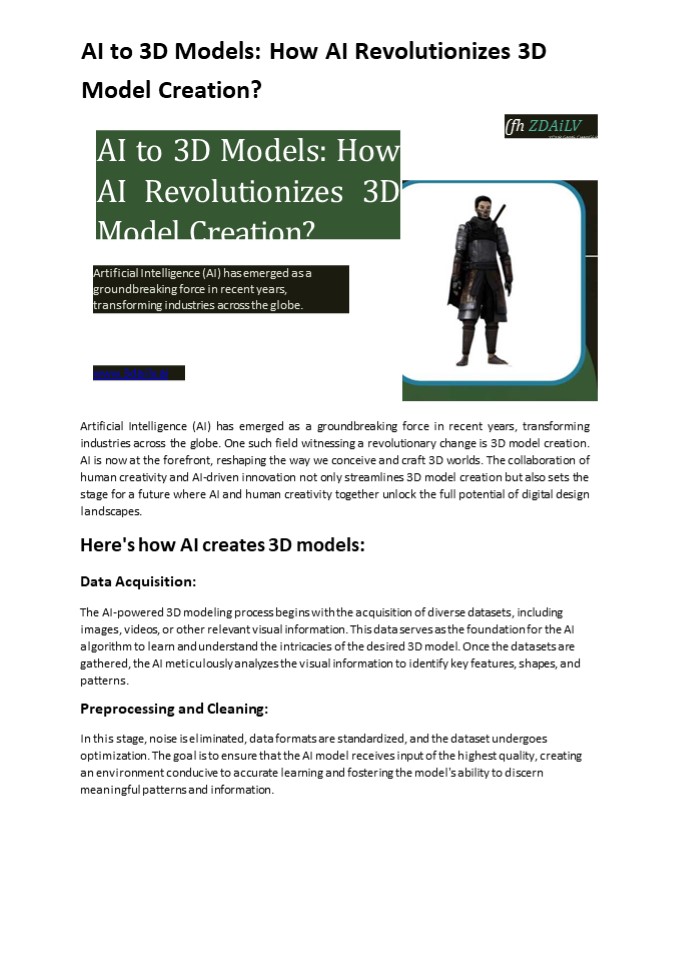AI to 3D Models: How AI Revolutionizes 3D Model Creation? - PowerPoint PPT Presentation
Title:
AI to 3D Models: How AI Revolutionizes 3D Model Creation?
Description:
Artificial Intelligence (AI) has emerged as a groundbreaking force in recent years, transforming industries across the globe. One such field witnessing a revolutionary change is 3D model creation. AI is now at the forefront, reshaping the way we conceive and craft 3D worlds. Visit – PowerPoint PPT presentation
Number of Views:4
Title: AI to 3D Models: How AI Revolutionizes 3D Model Creation?
1
AI to 3D Models How AI Revolutionizes 3D Model
Creation?
(fh ZDAiLV YOUR GAME CHANGER
AI to 3D Models How AI Revolutionizes 3D Model
Creation?
Artificial Intelligence (AI) has emerged as a
groundbreaking force in recent years,
transforming industries across the globe.
www.3daily.ai
Artificial Intelligence (AI) has emerged as a
groundbreaking force in recent years,
transforming industries across the globe. One
such field witnessing a revolutionary change is
3D model creation. AI is now at the forefront,
reshaping the way we conceive and craft 3D
worlds. The collaboration of human creativity and
AI-driven innovation not only streamlines 3D
model creation but also sets the stage for a
future where AI and human creativity together
unlock the full potential of digital design
landscapes. Here's how AI creates 3D models Data
Acquisition The AI-powered 3D modeling process
begins with the acquisition of diverse datasets,
including images, videos, or other relevant
visual information. This data serves as the
foundation for the AI algorithm to learn and
understand the intricacies of the desired 3D
model. Once the datasets are gathered, the AI
meticulously analyzes the visual information to
identify key features, shapes, and
patterns. Preprocessing and Cleaning In this
stage, noise is eliminated, data formats are
standardized, and the dataset undergoes
optimization. The goal is to ensure that the AI
model receives input of the highest quality,
creating an environment conducive to accurate
learning and fostering the model's ability to
discern meaningful patterns and information.
2
Training the AI Model
This important step sees the model immersed in a
learning experience, extracting patterns, shapes,
and features from the preprocessed data. The
choice between supervised or unsupervised
learning techniques is made based on the
complexity of the envisioned 3D models. In
supervised learning, the model is guided by
labeled data, while unsupervised learning allows
it to autonomously discern patterns within the
dataset, both methods serving to provide the
knowledge required to go from AI to 3D
models. Feature Extraction In the feature
extraction phase, the AI model discerns and
isolates pertinent features from the learned
patterns, pinpointing key elements integral to
constructing the 3D model. This critical step
plays a pivotal role in capturing the details
essential for achieving a realistic and accurate
representation. Generative Processes Leveraging
generative algorithms, such as Generative
Adversarial Networks (GANs) or Variational
Autoencoders (VAEs), the AI begins the process of
generating the 3D model. These algorithms use
learned features to create new data points,
constructing a three-dimensional representation
based on the patterns identified during
training. Refinement and Iteration The initial
output may undergo refinement through iterative
processes. AI models often refine their creations
by comparing them to the original dataset, making
adjustments to enhance accuracy and realism. This
iterative refinement ensures a continuous
improvement in the generated 3D models.
Validation and Testing
3
To guarantee that the created 3D model is
accurate to the original data and meets the
required standards, it is put through an
extensive testing and verification process. This
step involves evaluating factors such as
accuracy, detail, and overall quality of the
model. Optimization for User Interaction In
cases where user interaction is essential, the AI
model may undergo optimization to facilitate
customization or manipulation by end-users. This
step ensures that the final 3D model is not only
accurate but also user-friendly for applications
like design software or virtual
environments. Deployment and Integration
Once the AI model produces satisfactory results,
it is deployed for practical use. This could
involve integration into various industries, such
as gaming, architecture, healthcare, or
manufacturing, where the AI-generated 3D models
serve specific purposes aligned with the needs of
the respective field. Continuous Learning and
Improvement The AI model continues to learn and
adapt even after deployment, with ongoing updates
based on new data and user feedback. This
learning process ensures that the AI creates 3D
models that are accurate representations,
evolving to meet the demands of an ever-changing
technological landscape. Conclusion As we stand
on the precipice of a new era, the journey from
AI to 3D model creation promises to redefine the
boundaries of what is possible. The collaboration
of cutting-edge technology and artistic
expression opens up a world of opportunities. The
best 3D modeling softwares and 3D modeling tools
like 3Daily now employ AI to get the best result
possible. The journey has just begun, and the
future of 3D modeling holds more promise.

